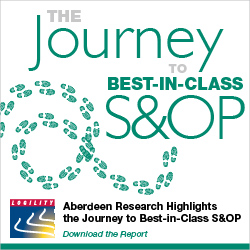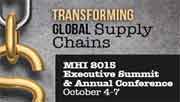 |
October 8, 2015 - Supply Chain Flagship Newsletter |
 |
| FEATURED SPONSOR: LOGILITY |
||
 |
||
Download the Aberdeen Group's S&OP: Beyond the Demand/Supply Match |
 |
|
||||||||||||||||||||||||||||||||||||||||||||||||||||||||||||||||||||||||||||||||||||||||||||||||||
So why had I never attended MHI before, and why did I say "improved" relative to this event? The conference has been around I believe for decades, but until last year was almost exclusively for MHI members, who range from WMS software vendors through DC automation solution companies to racking and fork truck battery charging equipment providers - quite a range indeed. But under relatively new MHI CEO George Prest, the organization has become much more aggressive, and is clearly swinging for the more general supply chain fences. That manifests itself, for example, in the bi-annual MODEX show in Atlanta, which MHI has had some success in positioning as a true supply chain event, versus the historical focus of the other year ProMat show on traditional materials handling. The name change to just MHI is of course also reflective of this strategy, as was the development in 2014 of the US Roadmap for Material Handling & Logistics, which clearly has an overall supply chain orientation despite the title.
So MHI wants to make this conference a "world class supply chain event," attracting attendees beyond its own MHI members. In the past, the conference had some good content from outsiders, but was at least as much dominated by meetings by the numerous MHI industry groups. Starting last year, that aspect is somewhat downplayed, and the external speakers and content are much on the rise. To cross this bridge will not be easy or cheap, but I believe MHI is in strong financial position right now, with both the ProMat and MODEX shows bringing in a lot of cash, and the environment for most of its company members is strong, likely meaning membership is also likely healthy. MHI seems very willing to invest to make this a more general conference, including for example having as a keynoter this year Mike Rowe of "Dirty Jobs" fame, who I am sure commands a hefty fee. That said, while I saw a few interesting "end user" badges at this year's event, they were a small minority of the 550 or so attendees. We will just have to see going forward. Moving to a new market is never easy. Again this year, the keynote presentations were almost all excellent. On Sunday was the "executive summit," which featured entrepreneur and "disruptive innovation" expert David Roberts. Unfortunately, I missed the first half of his session, and catching up with the flow is often hard. That said, he made the interesting point that China's Alibaba is one of the world's leading retailers but carries no inventory, taxi company Uber has achieved this giant market valuation yet owns no taxis, while Airbnb has a huge valuation as a hotelier but owns no hotels. Roberts sees huge opportunity in the virtual reality world, including in the supply chain, and I will note at last year's ProMat show we featured a Euro company that offered a very cool virtual reality platform for training fork truck drivers. So as I putt this together, could you perhaps become a leading toy company and actually make no physical toys? Maybe yes. He also provocatively forecast that when Tesla reaches its goal of a third generation electric car that will sell for some $35,000 it will likely dominate the market and put many current auto OEMs out of business. Our good friend David Simchi-Levi from MIT was there to present his excellent supply chain Risk Exposure Index (REI), much of which saw its first public airing either in Supply Chain Digest or our Supply Chain Television Channel. To greatly simplify, developing the REI for a given supply chain involves calculating the time-to-recovery (TTR) in each supply chain node if a major disruption is encountered, and the financial impact of that disruption. Add in to that the concept of time-to-survival (TTS) - how long a company can continue to meet market demand if a given node goes down, generally through pipeline inventories plus how long it would take to switch production (internally or from a supplier) to another facility. If TTS is greater than TTR (i.e., you can survive longer than it takes the node to recover) you are in good shape - except there may be hundreds or thousands of nodes to analyze. How do you do that? Well, Simchi-Levi uses analytics to determine TTS and the financial impact of a disruption, greatly narrowing the field of which nodes need more detailed analysis to, for example, calculate and perhaps reduce time-to-recovery.
His 9-step process: (1) Assess current and future customer needs; (2) Audit internal supply chain capabilities against those customer requirements; (3) Evaluate supply chain game changers (trends, technology); (4) Analyze competitive supply chain capabilities (easier than you might think); (5) Survey current/emerging supply chain technologies; and (6) Incorporate supply chain risk planning.
|
|||||||||||||||||||||||||||||||||||||||||||||||||||||||||||||||||||||||||||||||||||||||||||||||||||
|
|||||||||||||||||||||||||||||||||||||||||||||||||||||||||||||||||||||||||||||||||||||||||||||||||||
|
|||||||||||||||||||||||||||||||||||||||||||||||||||||||||||||||||||||||||||||||||||||||||||||||||||
|
|
|
YOUR FEEDBACK
We received quite a bit of Feedback on last week's First Thoughts column on "The Supply Chain Efficient Frontier," in addition to the great email from Tom Davis featured above. Below are some additional Feedbacks. More next week.
Feedback on the Efficient Supply Chain Frontier
I don't really care if I get mentioned personally, but I did the first off the self commercial work on supply chain trade off curves when I was a scientist/programmer for IBM. I ended up applying for a patent with them, and won an award for it. The patent application covered graphical interaction with trade off curves in a general way that didn't mention supply chain in particular. I'm not sure if IBM followed through in terms of actually acquiring the patent. (I no longer work for IBM). But if they did, I have a good understanding of what it does and doesn't cover. I also published some algorithmic ideas with IBM that are in the public domain. It's worth pointing out that computing a trade off curve for a reasonably sized optimization problem is more "parallelizable" than computing a single optimal result for a really hard optimization problem. That is to say, if your optimization problem is really hard, then adding 100 computers to work on it parallel will be unlikely to give you a 100X (or even a 10X) speed up. But if you're optimization problem doesn't take that long to solve in one instance, and you need to solve 100 somewhat similar instances in order to compute a trade off curve, then 100 machines might actually get you (almost) a 100X improvement (and even more likely a 10X improvement). As we move into a cloud computing world, where 100 computers are not terribly hard to rent, this observation becomes more prescient. Hopefully, when combined with articles like this, it will result in trade off curves becoming a more common part of data analysis in general, and supply chain analysis in particular. Peter Cacioppi
|
||
Nice Article. We would like to understand how these curves are drawn and how we can understand them better. |
||
GREAT SUMMARY! One of Sean's last points was interesting. It leads to the question "Are we working on the right projects - the ones that will actually move the dot in the right direction?" But that’s another story. Bill Pritz
|
||
SUPPLY CHAIN TRIVIA ANSWER
Q: What percent of GDP do federal, state and local governments combined spend on road and highway construction and maintenance?
A: Someone who believes the idea that human capacity can be enhanced by technology – like implanting RFID chips in your hand to control objects.
| © SupplyChainDigest™ 2003-2015. All Rights Reserved. SupplyChainDigest PO Box 714 Springboro, Ohio 45066 |
POWERED BY: XDIMENSION
|






 Patrick Murzyn of Caterpillar gave another in what have been a series of excellent presentation by CAT execs in recent years on the company's on-going value chain transformation. I liked this comment early on: "When I come into the office I often don't know what to focus on. Whatever I was working on yesterday is trumped by something else new that has happened in the meantime."
Patrick Murzyn of Caterpillar gave another in what have been a series of excellent presentation by CAT execs in recent years on the company's on-going value chain transformation. I liked this comment early on: "When I come into the office I often don't know what to focus on. Whatever I was working on yesterday is trumped by something else new that has happened in the meantime."

